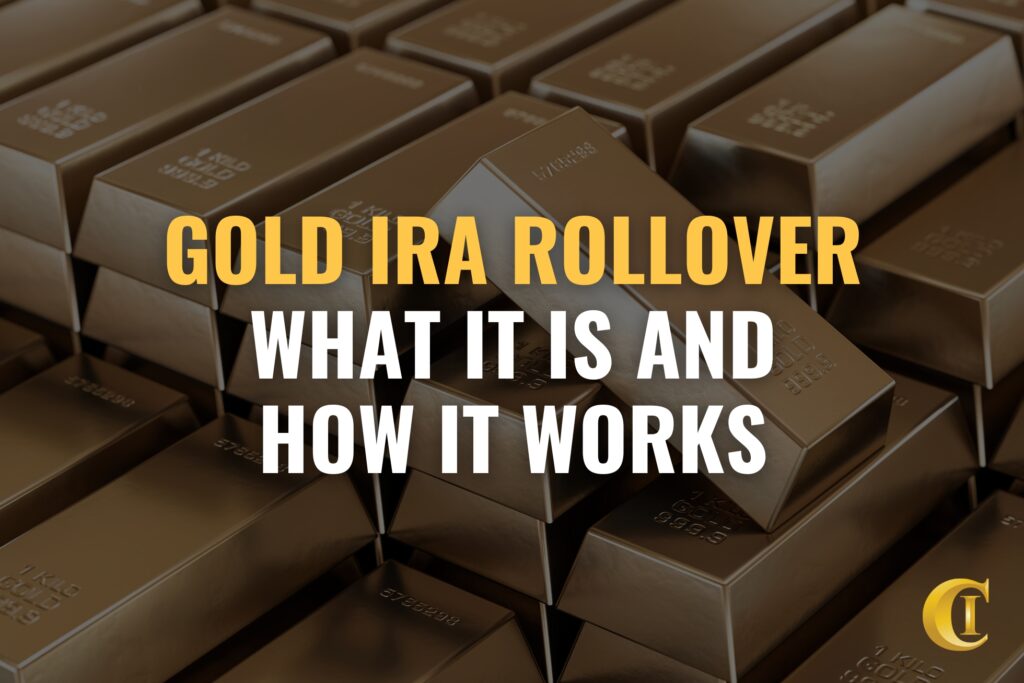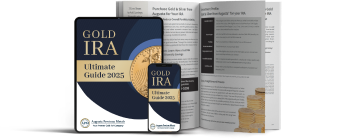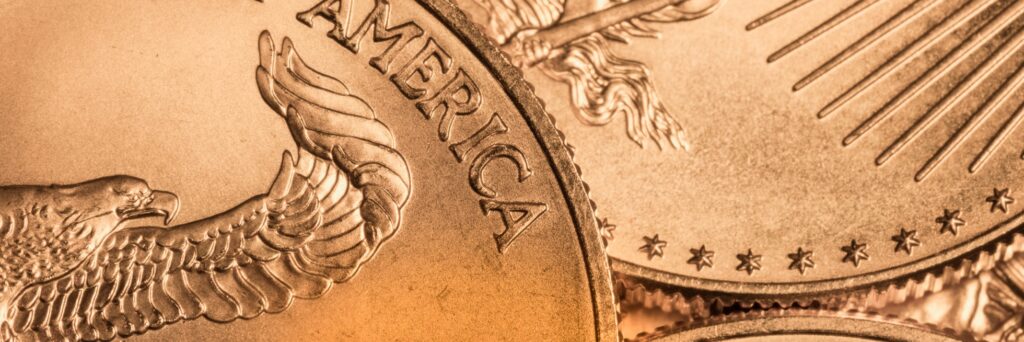Gold IRA Rollover: What It Is and How It Works
This guide explains how gold IRA rollovers work, the differences between direct and indirect rollovers, eligible accounts, tax implications, and what to expect from the process.

Written by Rick Erhart
Rick Erhart is an experienced precious metals professional with more than ten years in the field. He earned a degree in finance and is widely regarded as a specialist in self-directed IRAs.
Payments you receive from a retirement plan or IRA can generally be rolled over into a gold IRA within 60 days, provided you meet IRS rollover rules. Alternatively, you can arrange for your plan administrator to transfer the funds directly to the gold IRA custodian, which is often safer and avoids potential tax penalties.
What is a Gold IRA Rollover?
A gold IRA rollover refers to the process of transferring a portion of an existing retirement account, such as a 401(k), Roth IRA, or SEP IRA, into physical gold coins or bullion bars. This strategy helps protect your savings from economic instability and rising inflation.
Essentially, a gold IRA lets you hold tangible precious metals in your retirement account, with the benefit of tax-deferred or tax-free growth. You can set up and fund this type of account by moving assets or cash from an existing IRA. The process is straightforward and designed to maintain your retirement savings’ tax-advantaged status.
If you’re considering a gold IRA but feeling overwhelmed or unsure where to start, download our free gold IRA guide.
It offers a clear, simple breakdown of gold IRA rules, regulations, taxes, benefits, drawbacks, and detailed rollover information to help you make an informed decision.

When performing a rollover, the funds are withdrawn from your current account and must be redeposited into the new gold IRA within 60 days. This transfer occurs under the management of a new custodian or administrator to ensure compliance with IRS regulations.
Direct Gold IRA Rollover vs Indirect Rollover
When funding a gold IRA, investors can choose between two methods: a direct rollover or an indirect one. Gold IRA rollovers come with specific rules and conditions that investors must follow carefully. Breaking these rules can lead to costly penalties from the IRS.
| Indirect Rollover | Direct Rollover (Transfer) |
|---|---|
| A 60-day rule requires funds to be deposited into the new gold IRA within 60 days. | No 60-day deadline applies. |
| If the account holder is under 59.5 years old, withdrawn funds may face a 10% early withdrawal penalty. | No penalties for early withdrawal. |
| Funds not deposited within 60 days are treated as taxable income. | Not considered taxable income. |
| Limited to one rollover per 12-month period. | No limits on the number of transfers per year. |
| No tax withholding applies when rolling over from one personal IRA to another. | No taxes withheld during the process. |
Direct Rollover
A direct rollover involves moving funds directly from one custodian to another without the account holder ever handling the money. This hands-off approach is managed entirely by the custodians, reducing the risk of errors.
The funds never pass through the investor’s hands or personal bank account, ensuring a smooth and secure process. A direct rollover (also called transfer) is generally a safer and more streamlined option for moving assets between retirement accounts.
Indirect Rollover
With an indirect rollover, the investor receives the money and must deposit it into the new IRA within the 60-day window. Missing the deadline can trigger significant IRS penalties. The amount not rolled over is treated as a taxable distribution, subject to ordinary income tax based on your tax bracket.
If you’re under 59½, a 10% early withdrawal penalty may apply on the taxable amount, unless an exception (e.g., first-time home purchase, disability) applies. Plus, funds not rolled over lose their tax-deferred status, and future earnings become taxable.
For example, if you fail to roll over $10,000, it could be taxed at your income tax rate (say, 24% = $2,400) plus a 10% penalty ($1,000) if under 59½, totaling $3,400 in penalties and taxes, depending on your situation. Transfers, on the other hand, are less prone to such issues since the custodian handles everything automatically.
How to Complete a Gold IRA Rollover: A Step-by-Step Guide
To set up a gold IRA, follow the steps below. Your gold IRA company will guide you through each step, ensuring IRS compliance and secure handling of your investment.
- Choose a reputable gold IRA company and custodian
- Open a self-directed IRA
- Initiate a rollover
- Confirm funds and purchase metals
- Arrange secure storage
Select a Trusted Gold IRA Company and Custodian
Begin by researching and choosing a reputable gold IRA company. These companies specialize in self-directed IRAs and have established partnerships with secure storage facilities and custodians. A gold IRA company will guide you through the whole process and help you select IRS-approved precious metals for your investment.

Rated 9.8 out of 10
TOP-RATED GOLD IRA COMPANY
- Expert step-by-step rollover guidance
- Named “Best Gold IRA Company” by Forbes and Money magazine
- Trusted by thousands of customers (A+ BBB, AAA BCA, 1,000+ 5-star reviews)
You can access the full list of recommended gold companies here: “Best Gold IRA Companies for 2025 | Expert Review & Comparison“
Open a Self-Directed IRA
Collaborate with your chosen gold IRA company and custodian to set up a self-directed IRA. Unlike traditional IRAs, which are limited to stocks, bonds, or mutual funds, a self-directed IRA allows investments in physical precious metals. Complete the account application, providing personal details, beneficiary information, and a valid government-issued ID.
Initiate the Rollover Process
Once your self-directed IRA is open, you can start the rollover. Most gold IRA companies simplify this process, often with dedicated “rollover specialists” to assist. Here’s how it works:
- Reach out to the administrator of your current IRA or contact the plan administrator of your former employer if you have a 401(k).
- Fill out any required forms to request a transfer of your account balance to your new gold IRA provider.
Your gold IRA company will provide clear instructions on how the payment should be issued, including details like your new IRA account number and the mailing address for the check.
Some companies may allow a wire transfer as an alternative to a check. The preferred method is a direct rollover, where funds move directly from your old account to the new one without passing through your hands.
Alternatively, an indirect rollover involves withdrawing the funds yourself and depositing them into the new IRA within 60 days to avoid penalties.
Confirm Funds and Purchase Precious Metals
After the rollover funds reach your new gold IRA, verify with your custodian that the transfer is complete. Direct rollovers typically take a few days, while indirect rollovers may require up to five business days for checks to clear.
Next, select IRS-approved precious metals, such as gold bullion (99.5% pure) or specific coins like American Gold Eagles or Canadian Maple Leafs. Silver, platinum, or palladium may also qualify if they meet IRS standards. Your gold IRA company or custodian will help you purchase these metals, either by coordinating with dealers or offering a pre-approved selection.
Arrange Secure Storage
IRS rules require that gold IRA metals be stored in an approved depository, such as Brink’s or Delaware Depository, rather than at home or in a personal safe. These facilities provide high-level security, insurance, and 24/7 monitoring.
You can choose segregated storage, where your metals are kept separate, or commingled storage, which is more cost-effective but stores your assets with others. Discuss storage fees with your custodian, who will work with the depository to ensure your metals are safely stored and properly documented, including details like serial numbers and authentication certificates.
Eligible Precious Metals
Previously, IRAs were restricted to holding only American Eagle gold and silver coins. Now, IRAs can include IRS-approved gold, silver, palladium, and platinum bullion and coins.
This change came with the Taxpayer Relief Act of 1997, which broadened the range of precious metals permitted. Eligible options now cover one-half, one-quarter, or one-tenth ounce U.S. gold coins, as well as one-ounce silver coins produced by the U.S. Treasury Department. Certain foreign coins are also allowed.

To be included in a gold IRA, precious metals must meet specific purity standards. Gold needs to be 99.5% pure, silver 99.9% pure, and both platinum and palladium must reach 99.95% purity.
The metals should come from a refiner, assayer, or manufacturer accredited by NYMEX or COMEX, such as NYSE/Liffe, LME, LBMA, LPPM, TOCOM, ISO 9000, or a national government mint.
Precious metals must also bear the producer’s mint mark and meet fineness requirements. Proof coins require original mint packaging in excellent condition, complete with a certificate of authenticity.
Small bullion bars, excluding 400-ounce gold, 100-ounce gold, 1000-ounce silver, 50-ounce platinum, and 100-ounce palladium bars, are acceptable. Non-proof bullion coins must be in pristine, undamaged condition.
Account Types Eligible for a Gold IRA Rollover
You can fund a gold IRA rollover by transferring assets from various tax-advantaged retirement accounts. These include:
- Traditional or Roth IRA
- Employer-sponsored or self-directed 401(k)
- SEP IRA
- 403(b)
- 457(b)
- Thrift Savings Plan (TSP)
For employer-sponsored accounts like a 401(k) or 457(b), you may need to wait until you leave your job to initiate a rollover. Some employers restrict rollovers while you’re still employed. However, if you’re over 59.5, certain plans may allow a partial rollover even during employment.
To move funds into a gold IRA, start by opening a self-directed IRA with a trusted gold IRA provider. Next, complete a transfer request form to begin the process. Typically, the funds will appear in your new gold IRA within 14 business days, ensuring a smooth transition to your new account.
Are There any Gold IRA Rollover Fees?
There are no IRS-imposed fees for rolling over or transferring funds from an existing traditional IRA into a precious metals IRA, such as a gold IRA. However, certain costs may still apply depending on the custodian or administrator managing the account.
Many companies charge an account setup fee to open a self-directed IRA like a gold IRA. These fees vary, but the typical cost is around $50 for processing the account application. Be sure to check with your chosen provider for their specific fee structure to avoid surprises.
However, keep in mind that gold IRAs have some ongoing fees. They include:
- Annual Maintenance Fees: Custodians often charge annual fees for account administration. These fees typically range from $75 to $300, depending on the provider and account size.
- Storage Fees: Since physical precious metals must be stored in an IRS-approved depository, there are storage fees. These fees can range from $100 to $300 per year. This usually depends on the value of the metals and whether segregated or non-segregated storage is chosen.
- Transaction Fees: Some custodians charge fees for buying, selling, or transferring precious metals within the IRA. The fees can vary widely (e.g., $25–$100 per transaction).
Tax Implications of Gold IRA Rollovers by Account Type
The tax implications of a gold IRA rollover depend on the type of retirement account you’re transferring funds from.
Traditional IRA to Gold IRA
A Traditional IRA holds pre-tax contributions, meaning funds grow tax-deferred, and withdrawals are taxed as ordinary income.
When funds are transferred directly from a Traditional IRA to a gold IRA, there are no tax consequences. The funds retain their tax-deferred status in the new self-directed IRA, and no taxes are withheld.
If you receive the funds, you must deposit them into the gold IRA within 60 days. Failure to meet this deadline results in the withdrawn amount being treated as a taxable distribution. A taxable distribution is usually a subject to ordinary income tax based on your tax bracket.
If you’re under 59½, a 10% early withdrawal penalty may also apply unless an exception is met (see below). Additionally, the custodian may withhold 20% for federal taxes, which you’ll need to replace from other sources to complete a full rollover.
Roth IRA to Gold IRA
A Roth IRA holds after-tax contributions, meaning qualified withdrawals (after age 59½ and a 5-year holding period) are tax-free.
A direct transfer from a Roth IRA to a gold IRA incurs no taxes, as the funds remain in a tax-advantaged account. The Roth IRA’s tax-free growth continues in the gold IRA.
If you withdraw funds, you have 60 days to deposit them into the gold IRA. If you miss the deadline, the distribution may be taxable only if it includes earnings (not contributions, which are after-tax).
For example, if you withdraw $10,000 from a Roth IRA, with $7,000 in contributions and $3,000 in earnings, the $3,000 may be taxed as ordinary income if not rolled over. If under 59½, the earnings may also face a 10% penalty unless an exception applies. Unlike Traditional IRAs, Roth IRA rollovers typically don’t have mandatory tax withholding.
Other Accounts (e.g., 401(k), 403(b))
Employer-sponsored plans like 401(k)s or 403(b)s are usually pre-tax, similar to Traditional IRAs.
Direct rollovers to a gold IRA are tax-free, maintaining tax-deferred status. For indirect rollovers, the 60-day rule applies, and custodians often withhold 20% for federal taxes. Missing the deadline triggers income tax on the distribution and a potential 10% penalty if under 59½.
If rolling over a Roth 401(k), the tax treatment mirrors a Roth IRA, with contributions being tax-free but earnings potentially taxable if not rolled over within 60 days.
Conclusion
A gold IRA rollover offers a good way to gain exposure to precious metals and diversify your retirement portfolio. However, you have to adhere to IRS regulations to do things right.
You can seamlessly transfer funds from your existing retirement account with guidance from your gold IRA company. The long-term benefits of holding tangible assets in a tax-advantaged account can enhance your financial security.
To ensure a smooth process, work closely with a trusted custodian and carefully follow the necessary steps to safeguard your retirement savings for the future.
